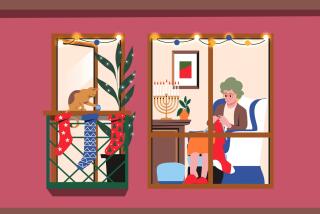Tree Ornaments Have New Glitter
- Share via
Question: Each year I add to my collection of Christmas tree ornaments. I have thousands of ornaments from many countries. What tips could you provide for adding to what I consider a unique collection?--T.R.
Answer: Collecting Christmas tree ornaments has become so popular that a thriving marketplace has developed. In recent years, smart collectors, aware of increased competition for quality ornaments, have started to pay attention to estate auctions in an effort to add to their collections. Some estates, according to dealers, include ornament collections that families had been building for generations.
That’s the good news.
The other side of the coin is that estate owners, administrators and auction houses are acutely aware of this situation and will often set aside ornament collections for separate sales. Therefore, you’ll have to keep an eagle eye trained on newspaper classified ads and read specialized collectible publications to keep your collection growing.
Some of the most valuable ornaments in collectors’ hands were crafted in and around Dresden, a city in East Germany with a distinguished history of producing some of the world’s finest glassware. Much of the early 19th-Century variety, according to dealers, was essentially one-dimensional, such as stars and toy soldiers.
But as Christmas tree ornaments became more popular, three-dimensional ornaments caught on. These range from animals to sleds to almost anything that could be associated with that special kind of nostalgia that wraps itself around the Christmas season.
Shortly after the Civil War, sales of glass ornaments from Germany and Czechoslovakia began to take off in the United States. Historians and collectors generally agree that the first ornaments, usually made of glass, were brought to America by Dutch and German residents of Pennsylvania.
Still, as popular as they were among these European descendants, tree ornaments really didn’t become popular until Frank Woolworth, a Lancaster, Pa., retailer, stumbled upon them.
A German importer, noting the sizable German population around Lancaster, offered Woolworth an opportunity to distribute the German-made ornaments. Woolworth, however, didn’t think they’d sell. He was finally convinced to purchase a few dollars worth of ornaments on a trial basis a few weeks before Christmas.
In a couple of days, Woolworth’s store sold out and, within a decade, Woolworth’s expanding chain was a major source for Christmas tree ornaments.
That collecting tree ornaments has become a profitable business is reflected in the fact that dealer catalogues list individual collectible ornaments for as much as $50 each; older, authenticated European ornaments can sell for $100 and up.
An offshoot of ornament collecting is Christmas tree light-bulb collecting, which became popular in the 1920s. These light bulbs come in various shapes, from Santa Claus to animals. Some of the more valuable ones are hand-painted turn-of-the-century bulbs from Europe.
Mailbag
Comic-book collectors should check out a new video titled “Comic Book Collecting and History.” Half an hour in length, it features a compilation of 50 years of comics history; tips by dealers on buying, selling and storing your collection; plus an interview with comic artist Steve Rude, creator and illustrator of NEXUS. Television and radio personality Gary Owens does the narration.
The video is produced by Cleary Communications (telephone: 805-254-6246) and distributed by Summit Media Co. (telephone: 1-800-777-8668). Suggested retail price: $19.95.


